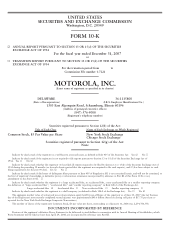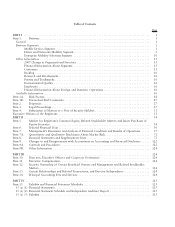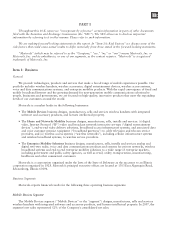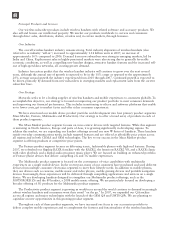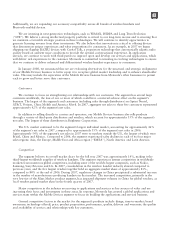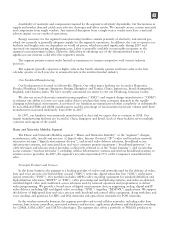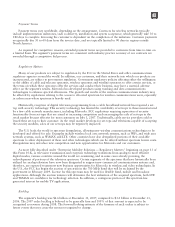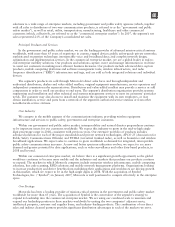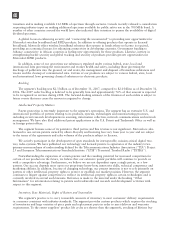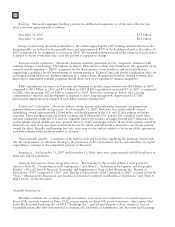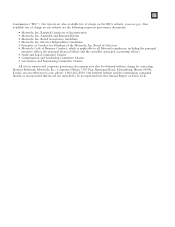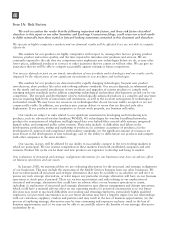Motorola 2007 Annual Report Download - page 16
Download and view the complete annual report
Please find page 16 of the 2007 Motorola annual report below. You can navigate through the pages in the report by either clicking on the pages listed below, or by using the keyword search tool below to find specific information within the annual report.
40 WiMAX trials globally. The segment is also leveraging its WiMAX investment to develop its LTE solution.
Vodafone and Verizon have launched a coordinated LTE trial in 2008. Motorola has been selected as a supplier to
support this trial with both infrastructure equipment and handsets.
Customers
The largest of the segment’s customers are Comcast, Verizon, KDDI (a service provider in Japan), China
Mobile and Sprint Nextel. In 2007, aggregate net sales to these five customers represented approximately 43% of
the segment’s net sales. The loss of any of the segment’s large customers could have a material adverse effect on the
segment’s business. Further, because many of these contracts are long-term, the loss of a major customer could
impact revenue and earnings over several quarters. Although sales in North America continued to account for a
majority of the segment’s sales, 48% of the segment’s net sales in 2007 were outside North America. The segment
experienced sales increases in all geographic regions in 2007 compared to 2006.
Competition
The businesses in which the segment operates are highly competitive. The rapid technological changes
occurring in each of the markets in which the segment competes are expected to lead to the entry of many new
competitors. Competitive factors in the market for the segment’s products and systems include: technology offered;
product and system performance; price; features; quality; delivery and availability. We believe that we are
competitively positioned because of our solid relationships with major communication system operators
worldwide, our technological leadership and our new product development capabilities. Price is a major area of
competition and often impacts margins for initial system bids, particularly in emerging markets. Time-to-market
has also been an important competitive factor, especially for new systems and technologies.
We compete worldwide in the market for digital entertainment devices for broadband networks. Based on
2007 annual sales, we believe we are the leading provider of digital cable and IPTV set-tops in North America.
Our digital cable and IPTV set-tops compete with products from a number of different companies, including:
(i) those that develop and sell products that are distributed by direct broadcast satellite service providers through
retail channels, (ii) those that develop, manufacture and sell products of their own design, and (iii) those that
license technology from us or other competitors. In North America, our largest competitor is Cisco. Other
competitors in North America include ARRIS, Ericsson (which entered the market in 2007 via the acquisition of
Tandberg) and Harmonic, Inc. Outside of North America, where we have a smaller market position, we compete
with many equipment suppliers, including several consumer electronics companies.
The traditional competitive environment in the North American cable market continues to evolve. On July 1,
2007, regulations enacted by the FCC became effective requiring separation of security functionality from set-tops.
To meet this requirement, we provide security modules to cable operators for use with both our own and third-
party set-tops. A full two-way security interface specification continues to be refined. Once developed and
implemented, these changes are expected to increase competition and encourage the sale of set-tops and integrated
devices, such as televisions and DVRs, that will allow retail customers direct access to programming. Traditionally,
cable service providers have leased the set-top to their customers.
We also compete worldwide in the market for broadband data and voice products. We believe that we are the
leading provider of cable modems worldwide, competing with a number of consumer electronic companies and
various original design manufacturers worldwide.
In the wireless networks market, there is widespread competition from numerous competitors, ranging from
some of the world’s largest diversified companies to foreign, state-owned telecommunications companies to many
small, specialized firms. Ericsson is the market leader, followed by the Nokia-Siemens joint venture, Alcatel-Lucent,
and two vendors with similar market share, Motorola and Nortel. Huawei, Samsung, NEC and ZTE are also
significant competitors.
The segment’s wireless networks business is confronting several factors that could impact its business,
including price competition, continuing consolidation among competitor telecommunications equipment providers,
a decline in our proprietary iDEN business, and vendor financing by competitors as customers continue to look to
vendors as an additional source of financing. The market for GSM access systems has become particularly price
competitive resulting in significant declines in gross margins in the market for those systems during 2006 and
2007.
8



